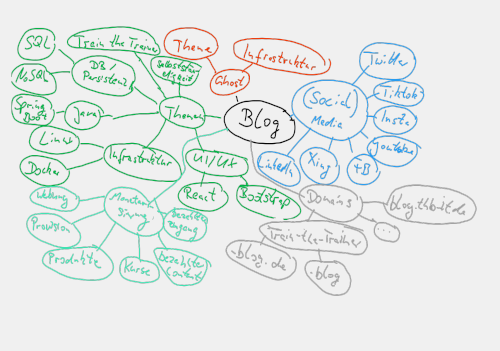Creative Techniques
Creative ways to develop and capture ideas with structure.
Creative Techniques
There are various creative techniques that help develop a topic or idea within a team or alone. They assist in broadening perspectives, thinking innovatively, and boosting motivation.
Problems and challenges can also be solved using creative techniques.
To fully harness creative techniques, it's essential to allow for craziness and free thinking without shame. Everyone involved must have permission and give themselves permission to think outside the box.
Below, different creative techniques are introduced and briefly explained.
Brainstorming
In brainstorming, all thoughts and ideas on a given topic are collected and written down. This can be effectively done using a (digital) flipchart or pinboard. It's not important for ideas to be connected. They are not judged or evaluated. The goal is simply to gather thoughts and ideas. Afterwards, these are evaluated.

ABC Method
The ABC method involves alphabetically collecting ideas and thoughts on a given topic. Each person writes the alphabet letters vertically on a sheet of paper. Then, a thought or idea for each letter related to the topic is found. When used in a team, results are shared and developed further.
Mind Mapping
Mind mapping creates a kind of map with ideas and thoughts. Unlike brainstorming, mind mapping follows a structure. The central theme is surrounded by related ideas and thoughts. Subtopics can emerge, which are also linked to ideas. These are structured and possibly color-coded. The mind map resembles a tree diagram in the end.

6-3-5 Method
This method is part of brainwriting techniques. Brainwriting involves non-verbal idea and thought collection. Unlike brainstorming and mind mapping, ideas are first written down individually before being shared and evaluated in the group.
The 6-3-5 method's name reveals its key features: 6 participants write 3 ideas each on a sheet of paper and pass it on 5 times. A time limit may be set by the team leader, after which all sheets are passed clockwise. Each participant should consider and ideally develop previous ideas on the sheet. In the end, many different ideas are gathered (potentially 108! 6 participants x 3 ideas x 6 rounds). After the final round, ideas are discussed and developed together.
Morphological Box
The morphological box helps systematically explore different solution variations. This technique is mainly used in product development. A table is drawn on paper or a flipchart/whiteboard. The first column lists parameters (features) the product has or should have, like size, shape, color, etc. Ideas for each parameter are collected in additional columns. The result is a kind of matrix. The task is to combine ideas to create a concrete product idea.
Creative Techniques in Seminar Context
Creative techniques can be helpful in many situations to develop ideas and uncover various solutions to a problem. They can also be used in seminar planning. For example, topics and subtopics for the seminar can be structured.
Creative techniques can also be applied within a seminar with participants. Which technique best achieves the desired goal must be individually assessed depending on the situation.
